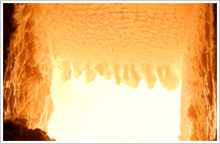- HOME
- Technology
- Development of environmentally-friendly products
Development of “Super Green Glass (NA32SG)”, free from substances that have an impact on the environment

With the emergence of environmental issues in recent years, the use of substances that have an impact on the environment during manufacturing is regulated around the world. Such regulations include the Restriction of Hazardous Substances (RoHS) Directive, the Waste Electrical and Electronic Equipment Directive (WEEE Directive) and the End of Life Vehicles Directive (ELV Directive) in Europe. AvanStrate has set its principles and basic policies in view of the global environment and is actively promoting a program to improve it. As part of the program, we are focused on the development of “Super Green Glass (NA32SG),” which is completely free from environmentally hazardous substances.
In the normal glass production process, substances that can have a negative effect on the environment are commonly used to remove the air bubbles generated when the raw materials are melted. Since the final products incorporating LCD glass substrates are used by general consumers, it is necessary to produce glass without using such substances to eliminate the impact on the human body and the environment.
As a socially responsible company, AvanStrate succeeded in establishing a technology that can maintain the quality of glass without the use of these substances by re-examining the furnace structure, gas fuel and the balance of the electric heating supply. Today, we provide “Super Green Glass (NA32SG),” which does not contain these substances, as our mainstay product.
“Super Green Glass melting furnace” with reduced CO2 emissions

The materials of glass are generally melted by heat generated by burning heavy oil or gas, but the Super Green Glass melting furnace uses a heating method primarily based on an electric heating source in consideration for the environment. Electric heating is superior to combustion heating in efficiency and can lower energy consumption while significantly reducing CO2 emissions. In addition, we use gas or pure oxygen in combustion heating to eliminate nitrogen, which constitutes 80% of the atmosphere. This minimizes the thermal NOx (nitrogen oxides) generated when nitrogen is oxidized at high temperatures. This scheme also improves the heating efficiency, thereby cutting down the amount of fuel used for combustion as well as CO2 emissions.






